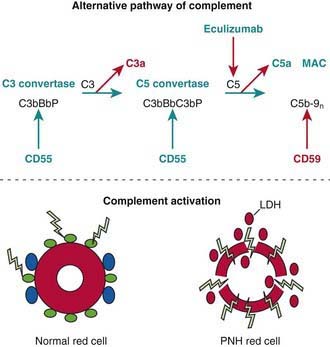Chapter 455 Other Membrane Defects
Paroxysmal Nocturnal Hemoglobinuria
Etiology
Paroxysmal nocturnal hemoglobinuria (PNH) reflects an abnormality of marrow stem cells that affects each blood cell lineage. The disease is not inherited; it is an acquired disorder of hematopoiesis characterized by a defect in proteins of the cell membrane that renders the red blood cells (RBCs) and other cells susceptible to damage by normal plasma complement proteins (see Fig. 455-1 on the Nelson Textbook of Pediatrics website at ![]() www.expertconsult.com). The deficient membrane-associated proteins include decay-accelerating factor, the C8 binding protein, and other proteins that normally impede complement lysis at various steps. The underlying defect involves the glycolipid anchor that maintains these protective proteins on the cell surface. Various mutations in the PIGA gene that are involved in glycosylphosphatidylinositol biosynthesis have been identified in patients with PNH. More than one PIGA gene mutation often occurs in an individual patient, suggesting multiclonality. Glycosylphosphatidylinositol-deficient cells are found at low frequency in normal persons, suggesting that injury to the normal marrow stem cells provides a selective advantage to the progeny of PNH clones in the genesis of this disease.
www.expertconsult.com). The deficient membrane-associated proteins include decay-accelerating factor, the C8 binding protein, and other proteins that normally impede complement lysis at various steps. The underlying defect involves the glycolipid anchor that maintains these protective proteins on the cell surface. Various mutations in the PIGA gene that are involved in glycosylphosphatidylinositol biosynthesis have been identified in patients with PNH. More than one PIGA gene mutation often occurs in an individual patient, suggesting multiclonality. Glycosylphosphatidylinositol-deficient cells are found at low frequency in normal persons, suggesting that injury to the normal marrow stem cells provides a selective advantage to the progeny of PNH clones in the genesis of this disease.




